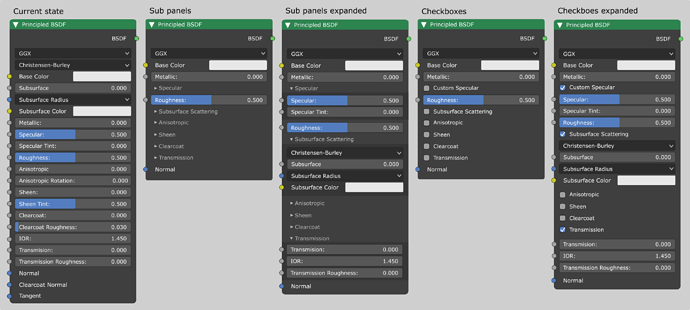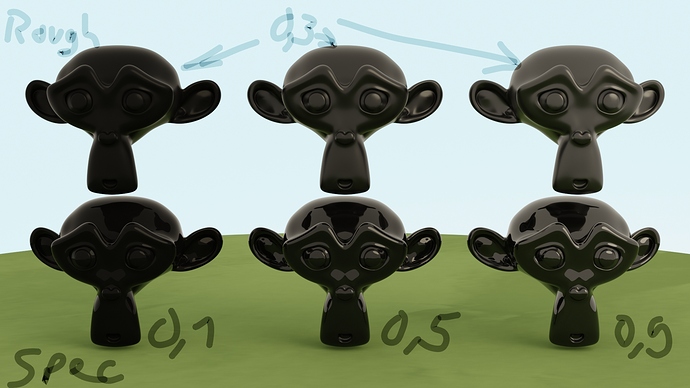Since every object in the entire universe reflects at least some of the light rays in a good manner, my thought is that the Specular input is unnecessary and should be removed. A Roughness of 1 is the equivalent of a specular of 0, which makes Specular redundant. Most 3D artists don’t even touch the Specular input and leave them at 0.5. Light reflection is exclusively controlled by Roughness.
The Principled BSDF is based on the paper by Disney that has been adopted as a standard in a lot of software:
We are not going to deviate from that, there’s good reasons it works the way it does.
Sorry if this is relatively off-topic, it’s still related to the fact that most of the time one doesn’t need the specular input in the Principled BSDF, as well as other components of it though.
Some time ago I did this mock-up intending to post it on RCS, in the end I didn’t but here it is:
Is something like this theoretically possible with how nodes are working right now?
See here:
Checkboxes are not that likely to be added, for compatibility with other software and easy material layering that we might add in the future.
Agree, from the Disney paper p.12:
In developing our new physically-based reflectance model, we were cautioned by artists that we needour shading model to be art-directable and not necessarily physically correct. Because of this, ourphilosophy has been to develop a “principled” model rather than a strictly physical one.
Why not simply tell that if there is a specular on an allready simplified node group it’s for a reason.
Yes all materials will have at least a bit of specular, but no, not all can be set to 0.5, even for an artistic way, we need to have the ability to make more or less shiny materials. Artistic way doesn’t means that we don’t understand what we are doing.
Sorry for the awfull GP, blend mode wasn’t working in viewport
Copied that. It was just a thought that it would be a way of realistic physically based shaders. In reality, glossiness is determined by the roughness of the surface on the microscopic level. So it seemed at bit weird to me that you can turn off specular altogether since in the real world everything can be shiny when it’s polished. Heck, Mythbusters even proofed that you can polish poop and make it glossy.
The Principled BSDF simulates a two layer material, there is a difference between the glossiness and the thickness of the top layer.
specular its a weird artistic conversion of IOR value (reflection in non transparent surfaces also uses IOR values), even when its not usually manipulated that value its needed when fine refinement comes into play.
Different surfaces has different IOR values, after that yes glossines its determined by roughness but first there is the IOR/“especular” to define a surface.
So yep that value needs to be there.

